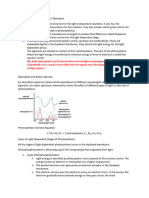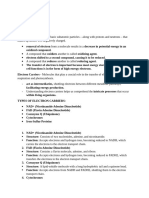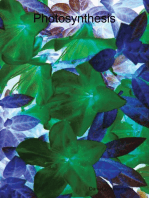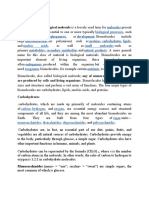Firefly Bioluminescence
Firefly Bioluminescence
Uploaded by
lucio_jolly_rogerCopyright:
Available Formats
Firefly Bioluminescence
Firefly Bioluminescence
Uploaded by
lucio_jolly_rogerOriginal Title
Copyright
Available Formats
Share this document
Did you find this document useful?
Is this content inappropriate?
Copyright:
Available Formats
Firefly Bioluminescence
Firefly Bioluminescence
Uploaded by
lucio_jolly_rogerCopyright:
Available Formats
Firefly Bioluminescence
Tarbiat Modares University Bruce R. Branchini
Introduction
Bioluminescence is an enchanting process in which living organisms convert chemical energy into light. With the interesting exception of the photoproteins see Spectroscopy and Structure , in most bioluminescence systems light results from the oxidation of an organic substrate, a luciferin, catalyzed by an enzyme called a luciferase. In nature, there is an amazing diversity of organisms that emit light including bacteria, fungi, crustaceans, mollusks, fishes and insects. While the specific biochemistries of bioluminescence are diverse, all include an enzyme-mediated reaction between molecular oxygen and an organic substrate. It is likely too that all bioluminescence processes involve the formation and breakdown of a four-member ring peroxide or a linear hydroperoxide. An overview of the chemical and mechanistic aspects of a major bioluminescence process, that of the bioluminescent beetles, will be presented here.
Figure 1. The North American firefly Photinus pyralis.
Representing an estimated 3,000 species of luminous beetles Coeleoptera , are three families: the true fireflies, click beetles, and glow-worms. Beginning approximately 50 years ago with the pioneering work of Johns Hopkins University scientists William McElroy, Emil White and Howard Seliger, basic research, mainly focused on the common North American firefly Photinus pyralis Figure 1 , has progressed toward a very good understanding of how light is produced by fireflies. It is anticipated that the availability of two Photinus pyralis luciferase crystal structures will advance the present understanding of the key structure-function relationships that account for the efficient enzyme-catalyzed emission of light in the firefly. In turn, the prospects are bright for the continued application of firefly bioluminescence to the already impressive list of medical and pharmaceutical methods, including in vivo luminescence monitoring and monitoring gene expression and regulation Biochemical Reactions of Bioluminescence
-1-
Firefly bioluminescence is a multi-step process that is outlined in Equations 1-3 shown in Figure 3 . Luc represents firefly luciferase, ATP is the universal biochemical energy source adenosine triphosphate, PPi is inorganic pyrophosphate, and the structures that correspond to the other abbreviations are shown below. In the first step Eq. 1 , luciferase converts firefly D-luciferin into the corresponding enzyme-bound luciferyl adenylate. Firefly luciferase has extraordinary specificity for this nucleotide triphosphate. The adenylate is the true substrate of the subsequent oxidative chemistry. In fact, D-LH2-AMP produced synthetically reacts with oxygen in the presence of luciferase to produce light emission identical to that obtained with the natural substrates D-luciferin and Mg-ATP.
As Equations 2 and 3 indicate, the luciferase enzyme functions as a mono-oxygenase, although it does so in a very unusual manner without the apparent involvement of a metal or cofactor. In some way that has not been yet determined, luciferase amino acid residues are recruited to promote the addition of molecular oxygen to luciferin, which is then transformed to an electronic excited state oxyluciferin molecule and carbon dioxide, each containing one oxygen atom from molecular oxygen. Visible light emission results from the rapid loss of energy of the excited state oxyluciferin molecule via a fluorescence pathway. The very high quantum yield for this process in alkaline solution, nearly each reacted LH2 molecule emits a photon reflects not only efficient catalytic machinery, but also a highly favorable environment for the radiative decay of an electronic excited state. Biochemical Reactions of Bioluminescence
-2-
Figure 3. Equations and structures illustrating the reactions catalyzed by firefly luciferase The symbol * denotes an electronic excited state.
Luc .
In addition to the reactions leading to light emission, firefly luciferase also catalyzes the in vitro formation of the adenylate of dehydroluciferin L-AMP Eq. 4 , which cannot react further and potently inhibits enzyme activity. Thus, luciferase exhibits two distinct enzymatic functions: as a synthetase in the formation of an acyl adenylate, and as a mono-oxygenase. Also, under certain conditions LH2-AMP, formed according to Eq. 1, may be oxidized by luciferase to produce low levels of L-AMP. Subsequently, luciferase catalyzes the transfer of the AMP moiety from L-AMP to ATP producing diadenosine tetraphosphate. These chemical transformations indicate that firefly luciferase can also function as a ligase. Furthermore, Coenzyme A can inhibit this ligase function and modulate the usual light emission kinetics, although the cofactor is not a required substrate. Coenzyme A is known to stimulate light production possibly by promoting the release of product oxyluciferin from luciferase allowing the enzyme to react again.
-3-
Generally Accepted Mechanism of Bioluminescence
The generally accepted mechanistic details of the overall process of firefly bioluminescence are presented in greater detail below Figure 4 .
Figure 4. Detailed mechanism of firefly bioluminescence including various proposals to account for the variation in color. The symbol * denotes an electronic excited state. Following the formation of the enzyme-bound luciferyl adenylate step a , a proton is abstracted from the C-4 carbon of the adenylate by a basic side chain amino acid residue of luciferase step b . Next, molecular oxygen adds to the newly formed anion step c ; and an electronically excited state oxyluciferin molecule and carbon dioxide are produced step e from a highly reactive dioxetanone intermediate step d . According to the original mechanism based predominantly on model studies of the P. pyralis enzyme, red light emission max 615 nm , which is observed at pH 6.0, results from the keto form of the emitter. At pH 8, the familiar yellow-green light emission max 560 nm is produced from the enolate dianion form of the excited state oxyluciferin by a presumed enzymatic assisted tautomerization step f . In nature,
-4-
beetle luciferases display various colors of light from green max ~540 nm to red max ~635 nm . Recent experimental data obtained with a firefly luciferin analog is consistent with the keto form of oxyluciferin alone being capable of producing all of the colors of firefly bioluminescence. Possibly, luciferase modulates emission color by altering the resonance-based charge delocalization of the excited state as shown in Eq. 5.
Alternatively, using molecular orbital calculations as the basis, McCapra has proposed that all of the luminescent colors ranging from green to red are generated from twisted intramolecular charge transfer excited states TICT of the keto form of oxyluciferin Figure 4 . Possibly, changes in luciferase tertiary structure might modulate color by affecting the stabilization of oxyluciferin conformers formed by rotation about the C2-C2' bond.
Electronic Excited State Formation
A relatively large amount of excitation energy is required to produce visible light, on the order of 40-70 kcal. The key dioxetanone intermediate shown in the reaction sequence above and in Figure 5, below, contains both a strained four member ring and a weak peroxide bond O-O . The cleavage of the high energy dioxetanone ring is capable of releasing sufficient energy as a result of the low energy of activation required to cleave the peroxide bond and the relief of the ring strain inherent in the structure.
Figure 5. Chemically initiated electron exchange CIEEL mechanism for the formation of excited state oxyluciferin in firefly bioluminescence.
-5-
In the firefly, the energy released is very efficiently directed into the production of an electronically excited state of the bioluminescence product oxyluciferin. Subsequent rapid relaxation of the excited state to the ground state is then accompanied by the emission of a photon of light. One detailed mechanistic view of this process is termed the CIEEL Chemically Initiated Electron Exchange Luminescence mechanism Figure 5 . In firefly bioluminescence, intramolecular electron transfer from the heterocylic portion of the molecule to the dioxetanone produces a radical ion pair and the radical anion of carbon dioxide. Next, the back transfer of an electron from the radical anion of carbon dioxide to the radical form of oxyluciferin results in the formation of electronically excited oxyluciferin and carbon dioxide. The CIEEL mechanism may occur in other bioluminescent systems as well as the firefly.
Firefly Luciferase Structure and Mechanistic Functions
The cloning and sequencing of P. pyralis luciferase and similar enzymes from approximately fifteen other beetle species has revealed that these luciferases are closely related to a large family of non-bioluminescent proteins that catalyze reactions of ATP with carboxylate substrates to form acyl-adenylates. The formation of enzyme-bound LH2-AMP and L-AMP Eqs. 1 and 4 illustrates the chemistry common to this large group of enzymes. This group of proteins shares an identifying motif 198SerSerGlySerThrGlyLeuProLysGly207 in luciferase and has been termed the acyl-adenylate/thioester-forming enzyme family. The superfamily of enzymes includes: a variety of acyl:CoA ligases; the acyl-adenylate-forming domains of enzyme complexes involved in the non-ribosomal synthesis of antibiotics, peptides and polyketides; the luciferases; and several other types of enzymes. Most of these enzymes generate thioester e.g., of Coenzyme A intermediates or products from the initially formed corresponding acyl-adenylates, and these reactions are similar to one suggested to account for the stimulatory effect of Coenzyme A on luciferase activity.
The P. pyralis luciferase crystal structure Figure 6 , the first structure of a member of the acyl-adenylate/thioester-forming enzyme family, revealed a unique molecular architecture consisting of a large N-terminal domain residues 1-436 and a small C-terminal domain residues 440-550 . The structure was solved without substrates or products present so it was not possible to determine which amino acid residues participated in the bioluminescence process. However, based on an analysis of the positions of several strictly conserved residues among a group of enzymes sharing the adenylation function, a general location of the luciferase active site was proposed.
Figure 6. Ribbon diagram of the firefly luciferase Luc structure. The large N-terminal domain amino acids 1-436 is connected to the smaller C-terminal domain amino acids 440-550 shown in yellow through a short hinge peptide from Conti, Franks and Brick. 1996 Structure 4, 287-298
-6-
Next, the crystal structure of a second member of the adenylate-forming family, the phenylalanine-activating subunit of gramicidin synthetase 1 PheA in a complex with phenylalanine, Mg ion and AMP, was reported. The active site of PheA was determined to be at the interface of the two domains, which were remarkably similar in size and shape to the corresponding domains of luciferase. In the PheA structure, however, the C-terminal domain was rotated 94 and was 5 closer to the N-terminal domain than in the luciferase structure. Starting with the two available crystal structures, molecular modeling techniques were used to produce a potential working model of the luciferase active site containing substrates luciferin and Mg-ATP. The model produced in our laboratory is shown in Figure 7.
This model has been quite useful in the rational design of site-directed mutagenesis-based luciferase structure-function studies, including several related to the determination of bioluminescence color and the characterization of the luciferin binding site.
Figure 7. Stereo diagram showing the substrate binding sites suggested by molecular modeling of luciferase with LH2 and ATP carbon atoms are green in both and Mg2+ ion not shown . The model was created starting with the luciferase x-ray structure 1LCI, and methylammonium ion labeled K529 was used to represent possible interactions of the Lys529 side chain. Traces through the -carbons of regions Val217-His221, His244-Thr252, His310-Leu319, and Arg337-Gly355 are shown as purple coils. The -carbons of Gly246, Ser314 and side chain group , Gly315, Gly316 and Gly341 are shown gray but are not labeled. The main chain carbonyl groups oxygen atoms are red of Gly339 and Thr352 also are shown. This diagram was generated using the program MOLSCRIPT.
Systematic mutation of fifteen luciferase amino acid residues and biochemical studies on the resulting mutant proteins has produced data substantiating the view of the firefly luciferin binding site shown in the stereo diagram below in Figure 8.
-7-
Figure 8. Stereo diagram showing the residues within 5 of LH2 at the putative luciferase substrate binding site suggested by molecular modeling of Luc with LH2 and ATP not shown and Mg2+ ion not shown . The model was created starting with the Luc X-ray structure 1LCI, and methylammonium ion labeled K529 was used to represent possible interactions of the Lys529 side-chain. Traces through the -carbons of regions V217-F219, H244-T252, I312-P318, and R337-P353 are shown as purple coils. This diagram was generated using the program MOLSCRIPT.
Based on mutational studies of the luciferases and enzymes in the related acyl adenylate-forming superfamily, a possible mechanism for the luciferasecatalyzed formation of adenylates Eqs. 1 and 4 is presented in Figure 9.
Figure 9. Schematic representation of hydrogen bonding between Luc and substrates luciferin green , ATP violet and Mg2+ predicted by molecular modeling. Potential interactions between substrates and atoms in close proximity ~2 to ~4 are indicated . For main chain mc atoms, only those interacting with substrates are included. The methylammonium ion was used to represent possible interactions of the Lys529 side chain. The curved blue arrows represent the nucleophilic attack of the luciferin carboxylate at the -phosphorus of ATP and the corresponding formation of the pentavalent intermediate.
-8-
Luciferase residues Arg218, Phe247, Ser347 and Ala348 are shown making H-bond interactions with luciferin, fixing its position in the active site. The adenine ring of ATP is held in place by interactions to Gly339, Tyr340, Gly341 and Ala317, while the side chain carboxylate of Asp422 is H-bonded to the ribose hydroxyl groups. Residues Ser199 and Lys206, highly conserved throughout the acyl adenylate forming superfamily are shown chelating the - and -phosphate portion of ATP. The key residue in the catalytic process mainly responsible for lowering the energy of the transition state is Lys529, which is probably assisted by Thr343. The side chain ammonium group of Lys529 first is shown orienting luciferin and ATP for a productive bimolecular reaction. The curved arrows show a carboxylate ion oxygen atom of luciferin carrying out a nucleophilic attack at the phosphorus atom of the -phosphate of ATP. A pentavalent transition state is formed that is likely stabilized by electrostatic interactions with the ammonium ion of Lys529 and H-bonding interactions with the side chain hydroxyl group of Thr343. Protein stabilization of the transition state accounts for the catalysis of the adenylation reaction. In addition, signature sequence residues Ser199 and Lys206 probably remove the PPi leaving group as the product adenylate is formed Figure 10.
Figure 10. Schematic representation of the possible role of signature sequence residues Ser199 and Lys206 in the removal of inorganic pyrophosphate PPi during the formation of lucferyl-adenylate. The curved arrows represent the flow of electrons leading to reformation of the phosphorus-oxygen double bond and release of PPi. Unfortunately, the mechanistic details relating the luciferase structure to its function as an oxidase Eqs. 2 and 3 are still not well understood. It does appear, however, that a structural motif identified in the acyl-adenylate forming superfamily, 340YGLTE344 in luciferase , plays a significant role in the catalysis of these reactions leading to the emission of light in the firefly. Research continues aimed at developing a detailed explanation of just how the firefly oxidizes its substrate to process the familiar lights many associate with beautiful warm summer evenings.
-9-
References
1. Wilson, T. 1995 Comments on the mechanisms of chemi- and bioluminescence. Photochem. Photobiol. 62, 601-606. 2. Hastings, J. W. 1995 Bioluminescence. In Cell Physiology Source Book Ed. pp 665-681, Academic Press, New York.
Sperelakis, N.,
3. Wood, K. V. 1995 The chemical mechanism and evolutionary development of beetle bioluminescence. Photochem. Photobiol. 62, 662-673. 4. DeLuca, M. 1976
Firefly luciferase. Adv. Enzymol. 44, 37-68.
5. McElroy, W. D. and M. DeLuca 1985 Firefly luminescence. In Chemi- and Bioluminescence Burr, J. G., Ed. pp 387-399, Marcel Dekker, New York. 6. White E. H., E. Rapaport, H. H. Seliger and T. A. Hopkins 1971 The chemi- and bioluminescence of firefly luciferin: an efficient chemical production of electronically excited states. Bioorg. Chem. 1, 92-122. 7. Conti, E., N. P. Franks and P. Brick 1996 Crystal structure of firefly luciferase throws light on a superfamily of adenylate-forming enzymes. Structure 4, 287-298. 8. Gould, S. J. and S. Subramani biology. Anal. Biochem. 175, 5-13..
1988
Firefly luciferase as a tool in molecular and cell
9. Contag, C. H., S. D. Spilman, P. R. Contag, M. Oshiro, B. Eames, P. Dennery, D. K. Stevenson and D. A. Benaron 1997 Visualizing gene expression in living mammals using a bioluminescent reporter. Photochem. Photobiol. 66, 523-531.
10. Campbell, A. K. and G. B. Sala-Newby 1993 Bioluminescent and chemiluminescent indicators for molecular signaling and function in living cells. In Fluorescent and Luminescent Probes for Biological Activity Mason, W. T., Ed. , pp 58-82, Academic Press, London.
11. Schuster, G. B., B. Dixon, J.-Y. Koo, S. P. Schmidt and J. P. Smith 1979 Chemical mechanisms of chemi- and bioluminescence. Reactions of high energy content organic compounds. Photochem. Photobiol. 30, 17-26.
12. Koo, J.-Y., S. P. Schmidt and G. B. Schuster 1978 Bioluminescence of the firefly: key steps in the formation of the electronically excited state for model systems. Proc. Natl. Acad. Sci. U.S.A. 75, 30-33. 13. Mager, H. I. X. and S.-C. Tu Photobiol. 62, 607-614. 14. McCapra, F.
1995
Chemical aspects of bioluminescence. Photochem.
1996
Mechanisms in chemiluminesence and bioluminesenceunfinished
- 10 -
business. In Bioluminesence and Chemiluminesence: Molecular Reporting with Photons Hastings, J. W., L. J. Kricka and P. E. Stanley, Eds. pp. 7-15, John Wiley and Sons, Chichester. 15. Sillero, A. and M. A. Gunther Sillero 2000 Synthesis of dinucleoside polyphosphates catalyzed by firefly luciferase and several ligases. Pharamcol. and Therapeutics 87, 91-102. 16. Branchini, B. R., R. A. Magyar, M. H. Murtiashaw, S. M. Anderson and M. Zimmer 1998 Site-directed mutagenesis of histidine 245 in firefly luciferase: a proposed model of the active site. Biochemistry 37, 15311-15319. 17. Viviani, V. R. 2002 The origin, diversity, and structure function relationships of insect luciferases. Cell. Mol. Life Sci. 59, 1833-1850. 18. May, J. J., Kessler, N., Marahiel, M. A., and Stubbs, M. T. 2002 Crystal structure of DhbE, an archetype for aryl acid activating domains of modular nonribosomal peptide synthetases. Proc. Natl. Acad. Sci. USA, 99, 12120-12125. 19. Branchini, B. R., R. A. Magyar, M. H. Murtiashaw and N. C. Portier 2001 The role of active site residue arginine 218 in firefly luciferase bioluminescence. Biochemistry, 40, 2410-2418. 20. Kraulis, P.J. 1991 A program to produce both detailed and schematic plots of protein structures. J. Appl. Cryst., 24, 946-950.
- 11 -
You might also like
- STPM Biology Past Year QuestionDocument8 pagesSTPM Biology Past Year QuestionMc Donalds Ohl Ohlsen100% (2)
- STPM BIOLOGY PhotosynthesisDocument13 pagesSTPM BIOLOGY Photosynthesiswkwhui100% (6)
- Photosystems I&iiDocument49 pagesPhotosystems I&iiObiajulu Crystal OnyinyechiNo ratings yet
- Koncz Dev Genet 11Document9 pagesKoncz Dev Genet 11Jazlynn WongNo ratings yet
- ShelouDocument2 pagesShelourichellemaypoculanNo ratings yet
- In The Light ReactionsDocument4 pagesIn The Light ReactionsAzmie Abu BakarNo ratings yet
- Photosynthesis NotesDocument12 pagesPhotosynthesis NotesSulthan Ramiz100% (1)
- botany-WPS OfficeDocument4 pagesbotany-WPS OfficerichellemaypoculanNo ratings yet
- LIGHT-REACTION-PHOTOSYNTHESIS (1)Document29 pagesLIGHT-REACTION-PHOTOSYNTHESIS (1)Dan Lexter LaulitaNo ratings yet
- Unit 5. Revision Notes in Accordance With Syllabus SpecificationsDocument16 pagesUnit 5. Revision Notes in Accordance With Syllabus SpecificationsShoaib Ahmed SamNo ratings yet
- Photosynthesis Study GuideDocument9 pagesPhotosynthesis Study GuideJunhee KimNo ratings yet
- Energy TransformationDocument4 pagesEnergy TransformationAsh Nico BanquilloNo ratings yet
- Photosynthesis (BIO CH 13)Document3 pagesPhotosynthesis (BIO CH 13)tamadesanmi1No ratings yet
- Chapter 6 - PhotosynthesisDocument113 pagesChapter 6 - PhotosynthesisFebian HenryNo ratings yet
- CHAPTER 21 PhotosynthesisDocument12 pagesCHAPTER 21 Photosynthesis楊畯凱No ratings yet
- 1587178802unit 3.1 PhotophosphorylationDocument8 pages1587178802unit 3.1 Photophosphorylationrajputshaurya256No ratings yet
- Unit 4 Photosynthesis-1Document7 pagesUnit 4 Photosynthesis-1Abraham BanjoNo ratings yet
- Photosynthesis COMPLETEDocument44 pagesPhotosynthesis COMPLETEsantoshnairsNo ratings yet
- PHOTOSYNTHESIS - Imran - Bs BotanyDocument26 pagesPHOTOSYNTHESIS - Imran - Bs Botanyhanza ahmadNo ratings yet
- Describe The Factors of Electron Flow Through LightDocument12 pagesDescribe The Factors of Electron Flow Through LightSha ShaNo ratings yet
- Photosynthesis: Leaves and Leaf StructureDocument11 pagesPhotosynthesis: Leaves and Leaf StructureMatthew BetinolNo ratings yet
- PhotosynthesisDocument31 pagesPhotosynthesismmobrecarinNo ratings yet
- Bio HWDocument9 pagesBio HWedgar batotoNo ratings yet
- Midterm NotesDocument2 pagesMidterm Noteshernys NietoNo ratings yet
- 28 PhotosynthesisDocument20 pages28 PhotosynthesisAngelNo ratings yet
- Laboratory 4 PhotosynthesisDocument13 pagesLaboratory 4 Photosynthesissydneymicheal721No ratings yet
- Biochemistry Lect 5 2011 Colour 2 Slides Per PageDocument11 pagesBiochemistry Lect 5 2011 Colour 2 Slides Per Pageyr0668No ratings yet
- Chapter 13 Photosynthesis in Higher PlantsDocument7 pagesChapter 13 Photosynthesis in Higher Plantsakhilkaushik.1327No ratings yet
- Series of EventsDocument10 pagesSeries of EventsMarvin JeaNo ratings yet
- Photosynthesis 5.2.1Document5 pagesPhotosynthesis 5.2.1bexNo ratings yet
- AP Biology Chapter 10 Notes - PhotosynthesisDocument5 pagesAP Biology Chapter 10 Notes - PhotosynthesisAustinNo ratings yet
- Gen-Bio-Reviewer-DUCZ (1)Document20 pagesGen-Bio-Reviewer-DUCZ (1)Alyssa AngananganNo ratings yet
- Photosynthesis, BY JOHN MANDONADocument6 pagesPhotosynthesis, BY JOHN MANDONAJohn MandonaNo ratings yet
- Unveiling The Light Reaction Event in PhotosynthesisDocument18 pagesUnveiling The Light Reaction Event in Photosynthesiszbplayer8No ratings yet
- Photosynthesis: Lecture 3 - 4 What Is The Moral of This Cartoon?Document6 pagesPhotosynthesis: Lecture 3 - 4 What Is The Moral of This Cartoon?Muhammad IqbalNo ratings yet
- Lecture 4 Carbohydrate-GlycolysisDocument20 pagesLecture 4 Carbohydrate-GlycolysisBiology BảoNo ratings yet
- AGR122 CHAPTER 4.3-PHOTOSYNTHESIS BaruDocument38 pagesAGR122 CHAPTER 4.3-PHOTOSYNTHESIS BaruAisyah NabilaNo ratings yet
- Lecture 18 Metabolic Diversity Among Microorganisms-Microbial PhotosynthesisDocument29 pagesLecture 18 Metabolic Diversity Among Microorganisms-Microbial Photosynthesisanilgarg9818812450No ratings yet
- Photosynthesis (Handouts)Document5 pagesPhotosynthesis (Handouts)Jelea MagallanesNo ratings yet
- Photosynthesis 9700 CieDocument8 pagesPhotosynthesis 9700 CietrinhcloverNo ratings yet
- Biotech Pres 29032016Document36 pagesBiotech Pres 29032016Marza ZareenNo ratings yet
- 8154_Photosynthesis dpsDocument6 pages8154_Photosynthesis dpsAshley kinNo ratings yet
- LM W2 Photosynthesis FDocument9 pagesLM W2 Photosynthesis FbladetopazdhilNo ratings yet
- Biology Unit 4 Part 1 Last Minute Revision ReallyacademicsDocument67 pagesBiology Unit 4 Part 1 Last Minute Revision ReallyacademicsWill AndyNo ratings yet
- BIO1 Lesson-12 PhotosynthesisDocument36 pagesBIO1 Lesson-12 PhotosynthesisCath Detoperez100% (1)
- Photosynthesis Consists of Light-Dependent and Light-Independent ReactionsDocument4 pagesPhotosynthesis Consists of Light-Dependent and Light-Independent Reactionsaby251188No ratings yet
- Lec04 MicroDocument13 pagesLec04 MicroMayurdhvajsinh JadejaNo ratings yet
- Aknowledgement: "Photochemistry of Carbonyl Compounds" Which Helped Me To GainDocument24 pagesAknowledgement: "Photochemistry of Carbonyl Compounds" Which Helped Me To GainSmitaNo ratings yet
- 11 Biology Notes ch13 Photosymthesis in Higher PlantsDocument6 pages11 Biology Notes ch13 Photosymthesis in Higher PlantsManan AhujaNo ratings yet
- Cape Biology PhosphorylationDocument7 pagesCape Biology PhosphorylationajimmoyaNo ratings yet
- PhotosynthesisDocument21 pagesPhotosynthesislorviejohnvfantilagan02No ratings yet
- 11 Biology Notes Ch13 Photosymthesis in Higher PlantsDocument6 pages11 Biology Notes Ch13 Photosymthesis in Higher PlantsAAYUSH KUMARNo ratings yet
- Chapter 4Document47 pagesChapter 4api-19968742No ratings yet
- Difference Between Oxidative Photophosphorylation and PhotophosphorylationDocument5 pagesDifference Between Oxidative Photophosphorylation and Photophosphorylationokaleboemmanuel53No ratings yet
- Energy Flow, Ecosystems and The EnvironmentDocument9 pagesEnergy Flow, Ecosystems and The EnvironmentafeefaNo ratings yet
- LIGHTDocument3 pagesLIGHTroberttuazon361No ratings yet
- Chap 3 PhotosynthesisDocument84 pagesChap 3 Photosynthesissarah575No ratings yet
- Class 9 Biology Notes For FBISE Bioenergetics Cha 7Document22 pagesClass 9 Biology Notes For FBISE Bioenergetics Cha 71990rupshaNo ratings yet
- Citrix Netscaler Gateway Secure Remote Access From Anywhere On Any DeviceDocument4 pagesCitrix Netscaler Gateway Secure Remote Access From Anywhere On Any Devicelucio_jolly_rogerNo ratings yet
- Basics of PhotogrammetryDocument63 pagesBasics of PhotogrammetryChevalier De BalibariNo ratings yet
- Citrix NetscalerDocument3 pagesCitrix Netscalerlucio_jolly_rogerNo ratings yet
- Cloudera Case StudyDocument4 pagesCloudera Case Studylucio_jolly_rogerNo ratings yet
- Cloudera Nokia Case Study FinalDocument2 pagesCloudera Nokia Case Study Finallucio_jolly_rogerNo ratings yet
- Specific Exercises For Discus Throwers: by V. Pensikov and E. DenissovaDocument9 pagesSpecific Exercises For Discus Throwers: by V. Pensikov and E. Denissovalucio_jolly_roger100% (1)
- I2727ethe State of World Fisheries and AquacultureDocument230 pagesI2727ethe State of World Fisheries and Aquaculturelucio_jolly_rogerNo ratings yet
- Basic Electrical SafetyDocument64 pagesBasic Electrical Safetydaltongifty100% (3)
- Reducing Datacenter ConsumptionDocument15 pagesReducing Datacenter Consumptionlucio_jolly_rogerNo ratings yet
- Phoenix Landing: Mission To The Martian Polar NorthDocument47 pagesPhoenix Landing: Mission To The Martian Polar Northlucio_jolly_rogerNo ratings yet
- Full Download Test Bank For Brock Biology of Microorganisms 14th Edition Michael T Madigan Download PDF Full ChapterDocument36 pagesFull Download Test Bank For Brock Biology of Microorganisms 14th Edition Michael T Madigan Download PDF Full Chapterandaracroselite.zumamo100% (21)
- Materi Modulbcdhmm 3.2 Defisiensi MikronutrienDocument58 pagesMateri Modulbcdhmm 3.2 Defisiensi MikronutrienKaroniNo ratings yet
- Dr. Kamal KV FINAL BOOST PDFDocument41 pagesDr. Kamal KV FINAL BOOST PDFReeba janetNo ratings yet
- Lecture 53 2015 LeaDocument33 pagesLecture 53 2015 LeaYehundinokibaathai FcNo ratings yet
- Archaebacteria 12847268357901 Phpapp01Document42 pagesArchaebacteria 12847268357901 Phpapp01Rudi Tabuti Bahar AlexaNo ratings yet
- 28 EnzymesDocument9 pages28 Enzymespschinnils03No ratings yet
- Advanced Nutritional BiochemistryDocument90 pagesAdvanced Nutritional BiochemistryAkinleye peter100% (1)
- MetabolismDocument27 pagesMetabolismAnum RasoolNo ratings yet
- Unit 1. Pharmacognosy Intro 2024-1Document91 pagesUnit 1. Pharmacognosy Intro 2024-1cheweblessings03No ratings yet
- EnzymesDocument18 pagesEnzymesKim TanNo ratings yet
- Krebsov CiklusDocument30 pagesKrebsov CiklusÉvariste GaloisNo ratings yet
- Linseed - Maheshwari-ThesisDocument78 pagesLinseed - Maheshwari-ThesisMahie MaheswariNo ratings yet
- EnzymeDocument15 pagesEnzymeSheena Mhae LopeñaNo ratings yet
- Enzyme Guided Notes Answer KeyDocument4 pagesEnzyme Guided Notes Answer KeyLö'vine Woo100% (1)
- Basic Tutorial DockThor 1.0 6Document17 pagesBasic Tutorial DockThor 1.0 6Emmanuel MarinhoNo ratings yet
- Vitamin b1 b2 b3Document22 pagesVitamin b1 b2 b3lillyrohith9No ratings yet
- Biological MoleculesDocument6 pagesBiological MoleculessanaullahNo ratings yet
- Enzymes 1Document54 pagesEnzymes 1Mayuri DhanushwarNo ratings yet
- Botany Ipe Vsaq'S: Chapter 1: ENZYMESDocument26 pagesBotany Ipe Vsaq'S: Chapter 1: ENZYMESThanujaNo ratings yet
- Secondary Metabolism NotesDocument11 pagesSecondary Metabolism Notesleanne_tan_4No ratings yet
- Multiple Choice Question On Vitamin DeficiencyDocument8 pagesMultiple Choice Question On Vitamin DeficiencyArun Shalini Singh100% (1)
- (CC-LEC-2) 1. Enzymes, Pt. 1Document6 pages(CC-LEC-2) 1. Enzymes, Pt. 1Zareena Joanna IbayNo ratings yet
- The Effect of Cofactor Binding On The ConformationalDocument11 pagesThe Effect of Cofactor Binding On The ConformationalRahul SarkarNo ratings yet
- Chapter 12 EnymesDocument6 pagesChapter 12 EnymesveymaramaNo ratings yet
- Enzymes MCQDocument3 pagesEnzymes MCQSundaralingam Raj80% (10)
- Vitamins MCQs PDFDocument5 pagesVitamins MCQs PDFBijay Kumar Mahato100% (1)
- BMB 514Document13 pagesBMB 514ehh2027100% (1)
- EnzymeDocument16 pagesEnzymeAndreNo ratings yet
- Chapter 3Document94 pagesChapter 3Serra ÖzışıkNo ratings yet
- Orca Share Media1463138182934 PDFDocument167 pagesOrca Share Media1463138182934 PDFJhon Raphael JimenezNo ratings yet



































































































